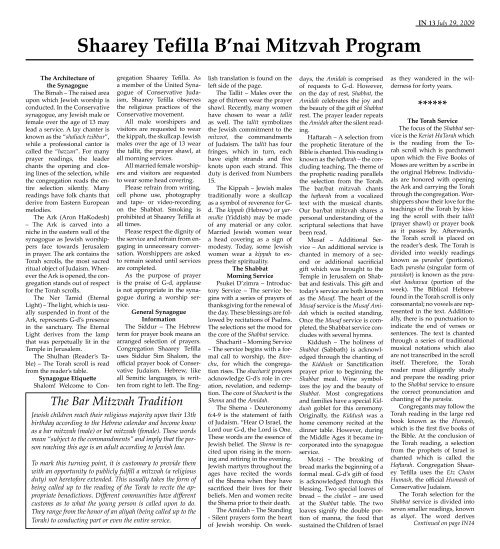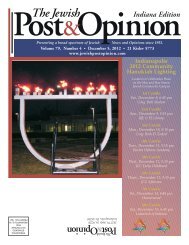bar\Bat Mitzvah - Jewish Post & Opinion
bar\Bat Mitzvah - Jewish Post & Opinion
bar\Bat Mitzvah - Jewish Post & Opinion
Create successful ePaper yourself
Turn your PDF publications into a flip-book with our unique Google optimized e-Paper software.
The Architecture of<br />
the Synagogue<br />
The Bimah – The raised area<br />
upon which <strong>Jewish</strong> worship is<br />
conducted. In the Conservative<br />
synagogue, any <strong>Jewish</strong> male or<br />
female over the age of 13 may<br />
lead a service. A lay chanter is<br />
known as the “shaliach tzibbur”,<br />
while a professional cantor is<br />
called the “hazzan”. For many<br />
prayer readings, the leader<br />
chants the opening and closing<br />
lines of the selection, while<br />
the congregation reads the entire<br />
selection silently. Many<br />
readings have folk chants that<br />
derive from Eastern European<br />
melodies.<br />
The Ark (Aron HaKodesh)<br />
– The Ark is carved into a<br />
niche in the eastern wall of the<br />
synagogue as <strong>Jewish</strong> worshippers<br />
face towards Jerusalem<br />
in prayer. The ark contains the<br />
Torah scrolls, the most sacred<br />
ritual object of Judaism. Whenever<br />
the Ark is opened, the congregation<br />
stands out of respect<br />
for the Torah scrolls.<br />
The Ner Tamid (Eternal<br />
Light) – The light, which is usually<br />
suspended in front of the<br />
Ark, represents G-d’s presence<br />
in the sanctuary. The Eternal<br />
Light derives from the lamp<br />
that was perpetually lit in the<br />
Temple in Jerusalem.<br />
The Shulhan (Reader’s Table)<br />
– The Torah scroll is read<br />
from the reader’s table.<br />
Synagogue Etiquette<br />
Shalom! Welcome to Con-<br />
Shaarey Tefilla B’nai <strong>Mitzvah</strong> Program<br />
gregation Shaarey Tefilla. As<br />
a member of the United Synagogue<br />
of Conservative Judaism,<br />
Shaarey Tefilla observes<br />
the religious practices of the<br />
Conservative movement.<br />
All male worshipers and<br />
visitors are requested to wear<br />
the kippah, the skullcap. <strong>Jewish</strong><br />
males over the age of 13 wear<br />
the tallit, the prayer shawl, at<br />
all morning services.<br />
All married female worshipers<br />
and visitors are requested<br />
to wear some head covering.<br />
Please refrain from writing,<br />
cell phone use, photography<br />
and tape- or video-recording<br />
on the Shabbat. Smoking is<br />
prohibited at Shaarey Tefilla at<br />
all times.<br />
Please respect the dignity of<br />
the service and refrain from engaging<br />
in unnecessary conversation.<br />
Worshippers are asked<br />
to remain seated until services<br />
are completed.<br />
As the purpose of prayer<br />
is the praise of G-d, applause<br />
is not appropriate in the synagogue<br />
during a worship service.<br />
General Synagogue<br />
Information<br />
The Siddur – The Hebrew<br />
term for prayer book means an<br />
arranged selection of prayers.<br />
Congregation Shaarey Tefilla<br />
uses Siddur Sim Shalom, the<br />
official prayer book of Conservative<br />
Judaism. Hebrew, like<br />
all Semitic languages, is written<br />
from right to left. The Eng-<br />
The Bar <strong>Mitzvah</strong> Tradition<br />
<strong>Jewish</strong> children reach their religious majority upon their 13th<br />
birthday according to the Hebrew calendar and become know<br />
as a bar mitzvah (male) or bat mitzvah (female). These words<br />
mean “subject to the commandments” and imply that the person<br />
reaching this age is an adult according to <strong>Jewish</strong> law.<br />
To mark this turning point, it is customary to provide them<br />
with an opportunity to publicly fulfill a mitzvah (a religious<br />
duty) not heretofore extended. This usually takes the form of<br />
being called up to the reading of the Torah to recite the appropriate<br />
benedictions. Different communities have different<br />
customs as to what the young person is called upon to do.<br />
They range from the honor of an aliyah (being called up to the<br />
Torah) to conducting part or even the entire service.<br />
lish translation is found on the<br />
left side of the page.<br />
The Tallit – Males over the<br />
age of thirteen wear the prayer<br />
shawl. Recently, many women<br />
have chosen to wear a tallit<br />
as well. The tallit symbolizes<br />
the <strong>Jewish</strong> commitment to the<br />
mitzvot, the commandments<br />
of Judaism. The tallit has four<br />
fringes, which in turn, each<br />
have eight strands and five<br />
knots upon each strand. This<br />
duty is derived from Numbers<br />
15.<br />
The Kippah – <strong>Jewish</strong> males<br />
traditionally wore a skullcap<br />
as a symbol of reverence for Gd.<br />
The kippah (Hebrew) or yarmulke<br />
(Yiddish) may be made<br />
of any material or any color.<br />
Married <strong>Jewish</strong> women wear<br />
a head covering as a sign of<br />
modesty. Today, some <strong>Jewish</strong><br />
women wear a kippah to express<br />
their spirituality.<br />
The Shabbat<br />
Morning Service<br />
Psukei D’zimra – Introductory<br />
Service – The service begins<br />
with a series of prayers of<br />
thanksgiving for the renewal of<br />
the day. These blessings are followed<br />
by recitations of Psalms.<br />
The selections set the mood for<br />
the core of the Shabbat service.<br />
Shacharit – Morning Service<br />
– The service begins with a formal<br />
call to worship, the Barechu,<br />
for which the congregation<br />
rises. The shacharit prayers<br />
acknowledge G-d’s role in creation,<br />
revelation, and redemption.<br />
The core of Shacharit is the<br />
Shema and the Amidah.<br />
The Shema - Deuteronomy<br />
6:4-9 is the statement of faith<br />
of Judaism. “Hear O Israel, the<br />
Lord our G-d, the Lord is One.<br />
These words are the essence of<br />
<strong>Jewish</strong> belief. The Shema is recited<br />
upon rising in the morning<br />
and retiring in the evening.<br />
<strong>Jewish</strong> martyrs throughout the<br />
ages have recited the words<br />
of the Shema when they have<br />
sacrificed their lives for their<br />
beliefs. Men and women recite<br />
the Shema prior to their death.<br />
The Amidah – The Standing<br />
- Silent prayers form the heart<br />
of <strong>Jewish</strong> worship. On week-<br />
days, the Amidah is comprised<br />
of requests to G-d. However,<br />
on the day of rest, Shabbat, the<br />
Amidah celebrates the joy and<br />
the beauty of the gift of Shabbat<br />
rest. The prayer leader repeats<br />
the Amidah after the silent reading.<br />
Haftarah – A selection from<br />
the prophetic literature of the<br />
Bible is chanted. This reading is<br />
known as the haftarah – the concluding<br />
teaching. The theme of<br />
the prophetic reading parallels<br />
the selection from the Torah.<br />
The bar/bat mitzvah chants<br />
the haftarah from a vocalized<br />
text with the musical chants.<br />
Our bar/bat mitzvah shares a<br />
personal understanding of the<br />
scriptural selections that have<br />
been read.<br />
Musaf – Additional Service<br />
– An additional service is<br />
chanted in memory of a second<br />
or additional sacrificial<br />
gift which was brought to the<br />
Temple in Jerusalem on Shabbat<br />
and festivals. This gift and<br />
today’s service are both known<br />
as the Musaf. The heart of the<br />
Musaf service is the Musaf Amidah<br />
which is recited standing.<br />
Once the Musaf service is completed,<br />
the Shabbat service concludes<br />
with several hymns.<br />
Kiddush – The holiness of<br />
Shabbat (Sabbath) is acknowledged<br />
through the chanting of<br />
the Kiddush or Sanctification<br />
prayer prior to beginning the<br />
Shabbat meal. Wine symbolizes<br />
the joy and the beauty of<br />
Shabbat. Most congregations<br />
and families have a special Kiddush<br />
goblet for this ceremony.<br />
Originally, the Kiddush was a<br />
home ceremony recited at the<br />
dinner table. However, during<br />
the Middle Ages it became incorporated<br />
into the synagogue<br />
service.<br />
Motzi - The breaking of<br />
bread marks the beginning of a<br />
formal meal. G-d’s gift of food<br />
is acknowledged through this<br />
blessing. Two special loaves of<br />
bread – the challot – are used<br />
at the Shabbat table. The two<br />
loaves signify the double portion<br />
of manna, the food that<br />
sustained the Children of Israel<br />
IN 1 July 29, 2009<br />
as they wandered in the wilderness<br />
for forty years.<br />
******<br />
The Torah Service<br />
The focus of the Shabbat service<br />
is the Keriat HaTorah which<br />
is the reading from the Torah<br />
scroll which is parchment<br />
upon which the Five Books of<br />
Moses are written by a scribe in<br />
the original Hebrew. Individuals<br />
are honored with opening<br />
the Ark and carrying the Torah<br />
through the congregation. Worshippers<br />
show their love for the<br />
teachings of the Torah by kissing<br />
the scroll with their tallit<br />
(prayer shawl) or prayer book<br />
as it passes by. Afterwards,<br />
the Torah scroll is placed on<br />
the reader’s desk. The Torah is<br />
divided into weekly readings<br />
known as parashot (portions).<br />
Each parasha (singular form of<br />
parashot) is known as the parashat<br />
hashavua (portion of the<br />
week). The Biblical Hebrew<br />
found in the Torah scroll is only<br />
consonantal; no vowels are represented<br />
in the text. Additionally,<br />
there is no punctuation to<br />
indicate the end of verses or<br />
sentences. The text is chanted<br />
through a series of traditional<br />
musical notations which also<br />
are not transcribed in the scroll<br />
itself. Therefore, the Torah<br />
reader must diligently study<br />
and prepare the reading prior<br />
to the Shabbat service to ensure<br />
the correct pronunciation and<br />
chanting of the parasha.<br />
Congregants may follow the<br />
Torah reading in the large red<br />
book known as the Humash,<br />
which is the first five books of<br />
the Bible. At the conclusion of<br />
the Torah reading, a selection<br />
from the prophets of Israel is<br />
chanted which is called the<br />
Haftarah. Congregation Shaarey<br />
Tefilla uses the Etz Chaim<br />
Humash, the official Humash of<br />
Conservative Judaism.<br />
The Torah selection for the<br />
Shabbat service is divided into<br />
seven smaller readings, known<br />
as aliyot. The word derives<br />
Continued on page IN14



